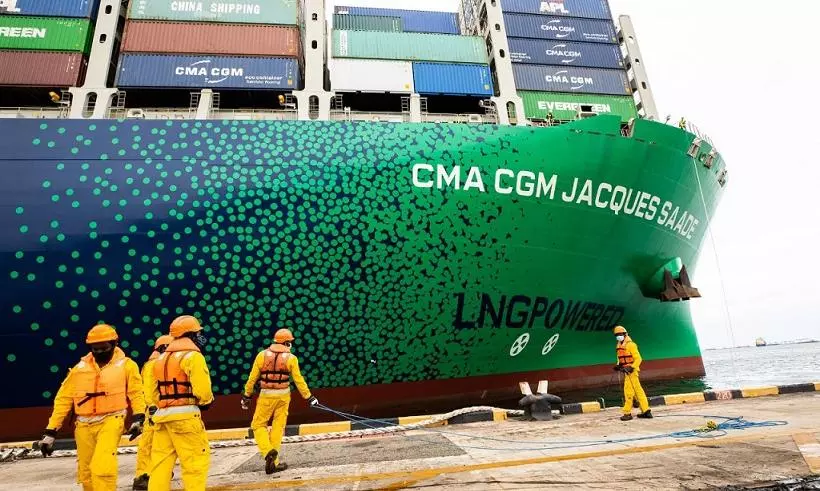PARIS (Reuters) – French transport giant CMA CGM is creating a five-year investment fund of 1.5 billion euros ($1.5 billion) aimed at accelerating its energy transition in shipping and logistics,
The fund will support industrial production of new fuels and low-emission transport solutions across the group’s businesses, including maritime, overland and air freight shipping and port and logistics services, it said in a statement.
Among other initiatives mentioned , the group will develop a biomethane production and liquefaction project to produce up to 100,000 tonnes by 2025, with the possibility of doubling output by 2027, it said.
CMA CGM also referred to a joint plan announced in June to partner energy group Engie in the production of 11,000 tonnes per year of biomethane in France starting in 2026.
On the other hand CMA CGM, privately controlled by the Saade family, reported second-quarter net profit more than doubled to $7.6 billion, also surpassing the first quarter.
Its soaring profits prompted the French government to call on the company this year to help to cushion inflationary pressures. CMA CGM responded with shipping rate discounts for cargoes to France.

The Fund follows on from projects that have already been identified and launched:
The Salamander Project will produce 11,000 tonnes of second-generation biomethane per year starting in 2026.
As part of the partnership with Engie, its target is to generate 200,000 tonnes of renewable gas per year by 2028, to serve the needs of CMA CGM and the entire shipping industry.
A biomethane production and liquefaction project, developed with Titan, will produce up to 100,000 tonnes by 2025, with the possibility of doubling output by 2027.

As a partner in the Jupiter 1000 project in Fos, the CMA CGM Group aims to continue working with the consortium on means to mass-produce low-carbon e-methane for its ships and provide solutions to the challenges of decarbonizing gas networks and managing the intermittent nature of certain renewables.
Second focus: Accelerating the decarbonization of port terminals, warehouses and truck fleets
The CMA CGM Group operates more than 700 warehouses and around 50 port terminals worldwide. It is committed to enabling these facilities to generate enough carbon-free electricity (wind, solar, biomass-fueled, hydrogen-fueled) to become energy self-sufficient.
Port equipment in use will be electrified more quickly wherever feasible and effective. CEVA Logistics, a CMA CGM subsidiary, aims to meet all its electricity needs through carbon-free power generation by 2025. The subsidiary has plans to install 1.8 million sqm of photovoltaic panels and expand the use of LED lighting.

A transition plan for the truck fleets will also be implemented, with a particular focus on electrifying CEVA Logistics trucks.
Third focus: Supporting, trialing and launching projects at the cutting edge of innovation
CMA CGM has long been involved in supporting the development of projects, prototypes and trials.
In February 2020, the Group joined forces with Energy Observer to make hydrogen one of the energy sources of tomorrow.
With the Energy Observer 2 project, the partners have taken a new step forward by working together on a prototype intra-regional container ship fueled by liquid hydrogen and designed to meet the latest technical and logistical standards.
The project is focused on developing practical applications for this new technology, to enable carbon-free maritime shipping on a larger scale, in particular for short distances.

The Group has also decided to acquire a stake in Neoline, a prototype sail-powered cargo ship set to serve transatlantic routes by the end of 2024. It is also supporting SeaOrbiter, a prototype marine research vessel and floating oceanographic laboratory designed by French architect Jacques Rougerie that is exploring pathways to the emerging blue economy.
The CMA CGM Group’s R&D team will continue to optimize the design and propulsion of large container ships to reduce their fuel use, while developing increasingly effective solutions to help make maritime, overland and air freight shipping more energy efficient.
Fourth focus: Pursuing energy savings and improving the energy efficiency of CMA CGM employee working methods and daily mobility
This fourth focus has three main objectives:
A building energy management plan for CMA CGM Group office buildings that will reduce energy use (investment in insulation, automation, energy renovation) and diversify their energy mix (solar panels, sea water loop).
Encouraging and incentivizing employee use of soft mobility solutions for both commuting and business travel, while improving the work-from-home systems used to avoid unnecessary travel.
Engaging the Group’s 150,000 employees through a holistic environmental approach that rewards innovative environmental protection and energy efficiency initiatives.
A fund supported by a USD 1.5 billion budget and a dedicated team
The Fund will be backed by a USD 1.5 billion budget and managed, starting in October 2022, by a dedicated team bringing together some of the Group’s most talented engineers, energy experts, financial analysts and project managers.
Operating as a cross-functional organization covering all the Group’s operations and divisions, it will guide the Group’s overall strategy towards developing low-carbon energy solutions and accelerating their implementation.
A special fund at the heart of an innovation ecosystem
The CMA CGM Group has always considered its financial performance inseparable from its social responsibility and environmental performance.
It is deeply committed to leading the way in decarbonizing the shipping and logistics industries by pioneering innovative, eco-friendly technologies. To do so, it is engaging an ecosystem of start-ups, R&D projects and a vast array of innovative stakeholders and next-generation tools.
Thanks to this Group-wide engagement, the Fund will give project champions and our industrial partners the visibility – via the Group’s demand for low-carbon energy sources – and the financial resources – via the fund’s investments – they need to make these solutions widely available as quickly as possible.














